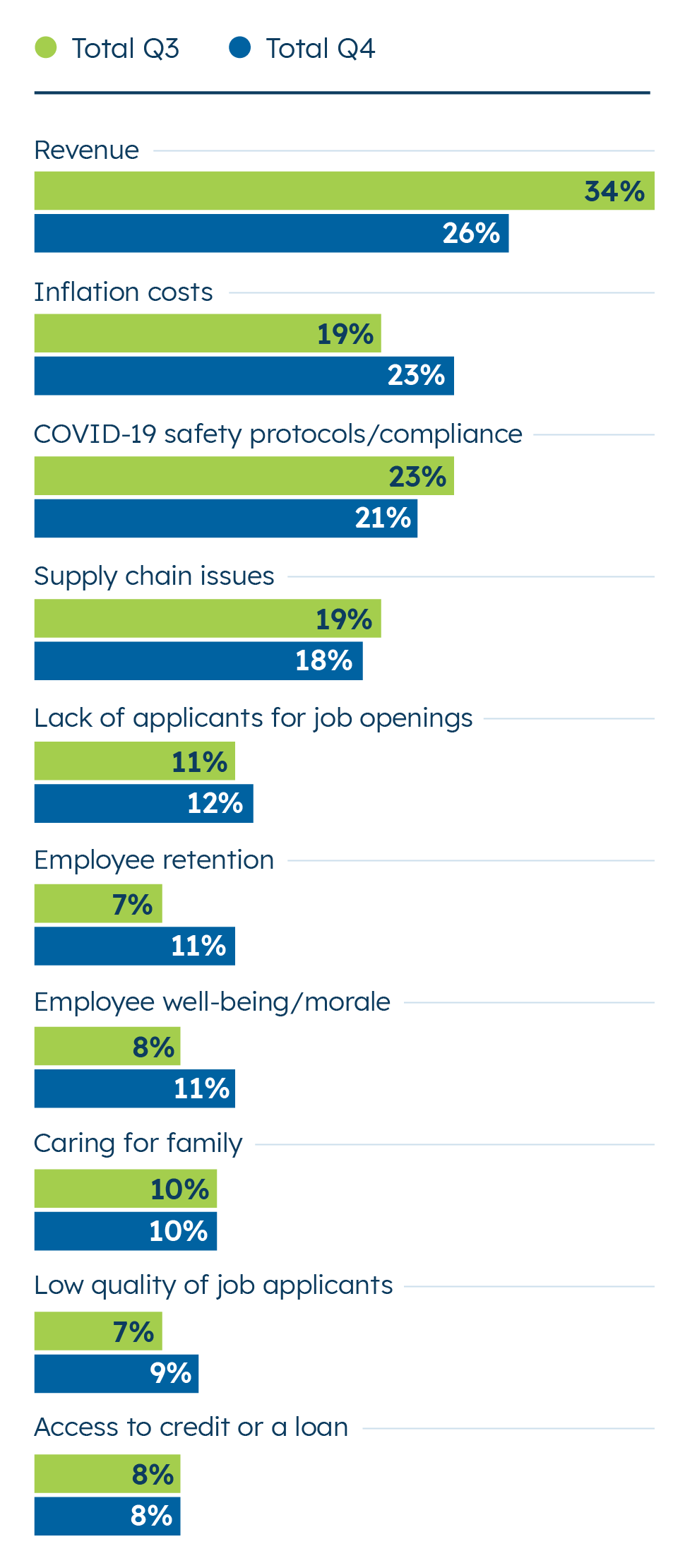Worker Shortages, Supply Chain Issues, and Inflation

Supply chain, COVID restrictions cause concern
As small businesses get more optimistic, a number of issues are causing them to plan for an unpredictable future.
Among small business owners’ top concerns are supply chain issues. About three in five (61%) small businesses say their supply chain has been dramatically disrupted by the COVID-19 pandemic. In fact, 18% of small businesses say they expect supply chain issues to be the biggest challenge they face coming out of the pandemic.
America’s ongoing worker shortage is also having a big impact on supply chains. A majority of small businesses (55%) say worker shortages have disrupted their supply chains. Sixty-three percent of small businesses say that they have had to alter their business’ supply chain in the past six months. All these supply chain disruptions may make it difficult for many small businesses to keep up with customer demand, with 47% of small business owners reporting that they are unable to do so.
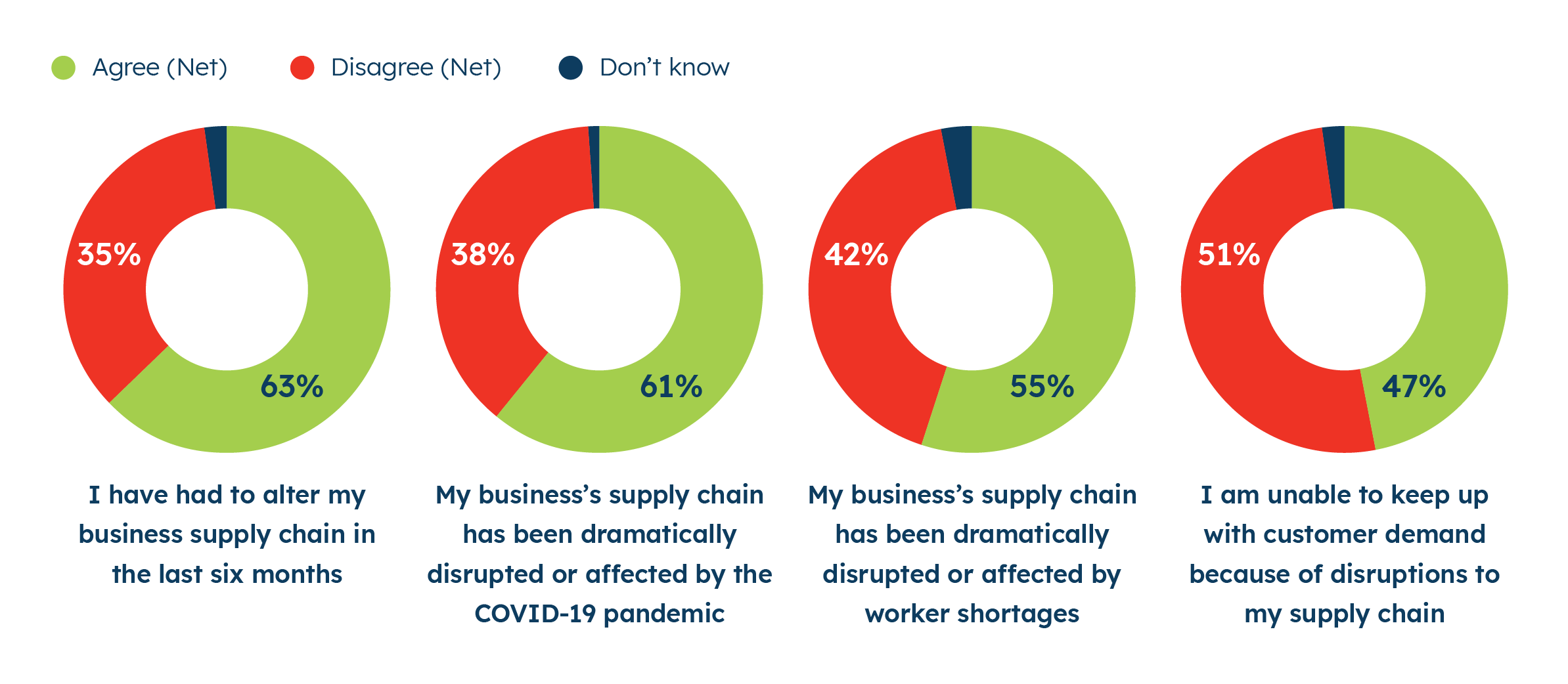
Founder and CEO, Francis Energy
Tulsa, Oklahoma
Small business retailers struggle the most with their supply chains, with 78% reporting the pandemic has disrupted their business’ supply chain and 68% saying worker shortages have done so. Three in five (61%) retailers say these disruptions leave them unable to keep up with customer demand, compared to less than half that say the same in other sectors.
Most small businesses that are experiencing supply chain issues caused by the pandemic see these issues lasting well into the next year. Among the 61% of small businesses that say the COVID-19 pandemic has disrupted their business’ supply chain, most think these disruptions will last six months or more. Almost two thirds (64%) say they expect supply chain disruptions to last at least six months, and among them, there is an even split between those who say disruptions will last six months to a year (32%) and those who say they will last more than a year (32%). Just over a quarter (28%) think disruptions to their supply chain will last less than six months.
Small businesses in the services sector are the least optimistic about their supply chains, with only 13% saying they expect disruptions to be relatively short (last less than six months). Around 30% or more of small businesses across other sectors say the same. In fact, almost four in five small businesses in the services sector (79%) think their supply chain disruptions will last at least another six months.
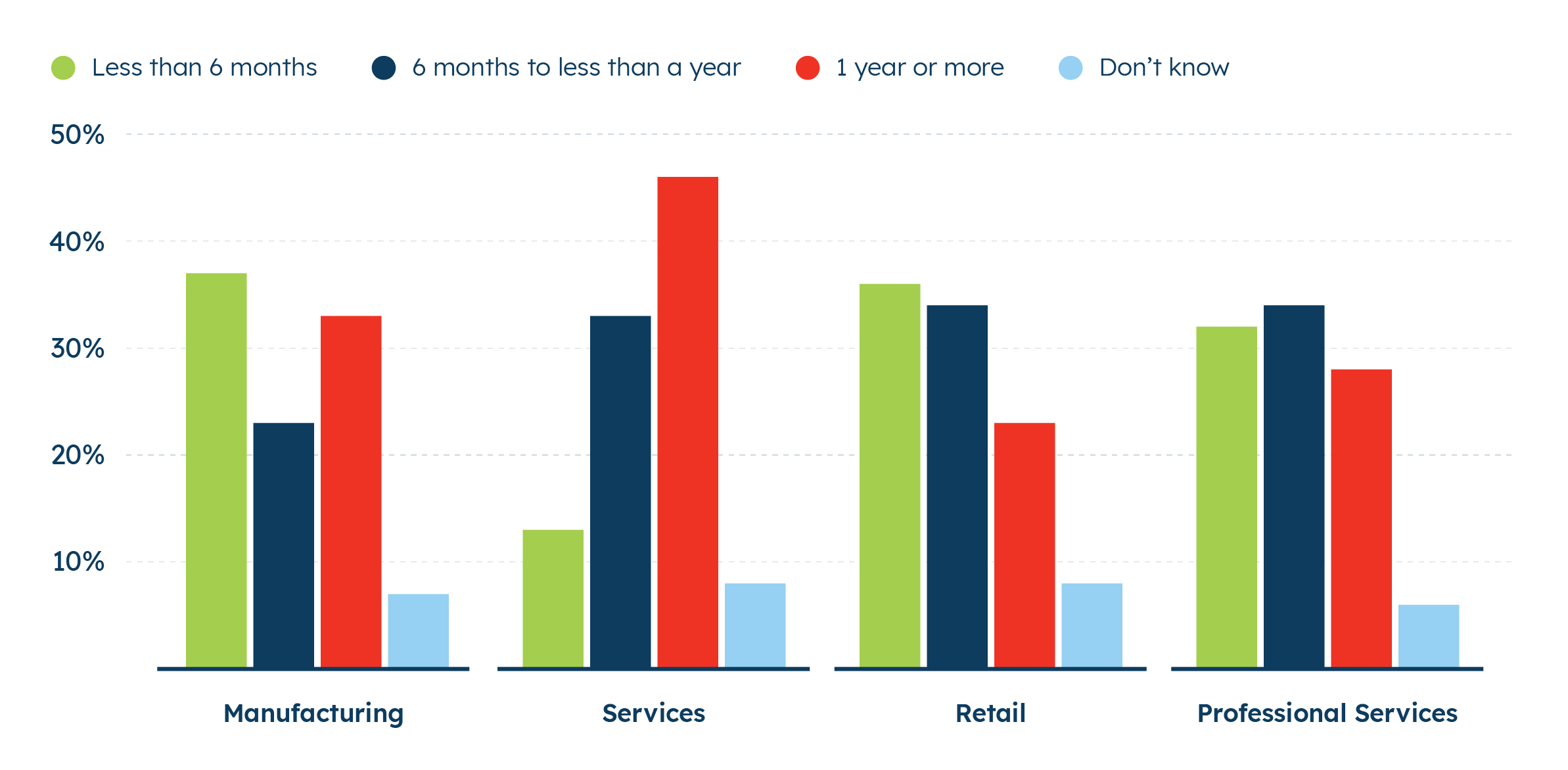

Inflation concerns linger as small businesses raise prices to cope
However, concerns about inflation are stable quarter-over-quarter: seven in ten (71%) small business owners say that rising prices have had a significant impact on their business in the past year, which is on par with the previous quarter (73%). Retailers say they see the biggest impact from rising prices: Small business retailers (78%) are the most likely to say they have been impacted by rising prices. Meanwhile, medium-sized small businesses with 5-19 employees (77%) and larger (73%) small businesses with 20-499 employees are slightly more likely than the smallest (67%) small businesses (with 1-4 employees) to agree.
Among the small businesses that say rising prices have had a significant impact on their business in the past year, the impact is seen most dramatically in the cost of goods and supplies they themselves have to purchase. Further down the list of things driving inflation pressure are: the cost of utilities/fuel, rent, and employee wages. Inflation appears to be an economy-wide phenomena and small businesses are feeling it.
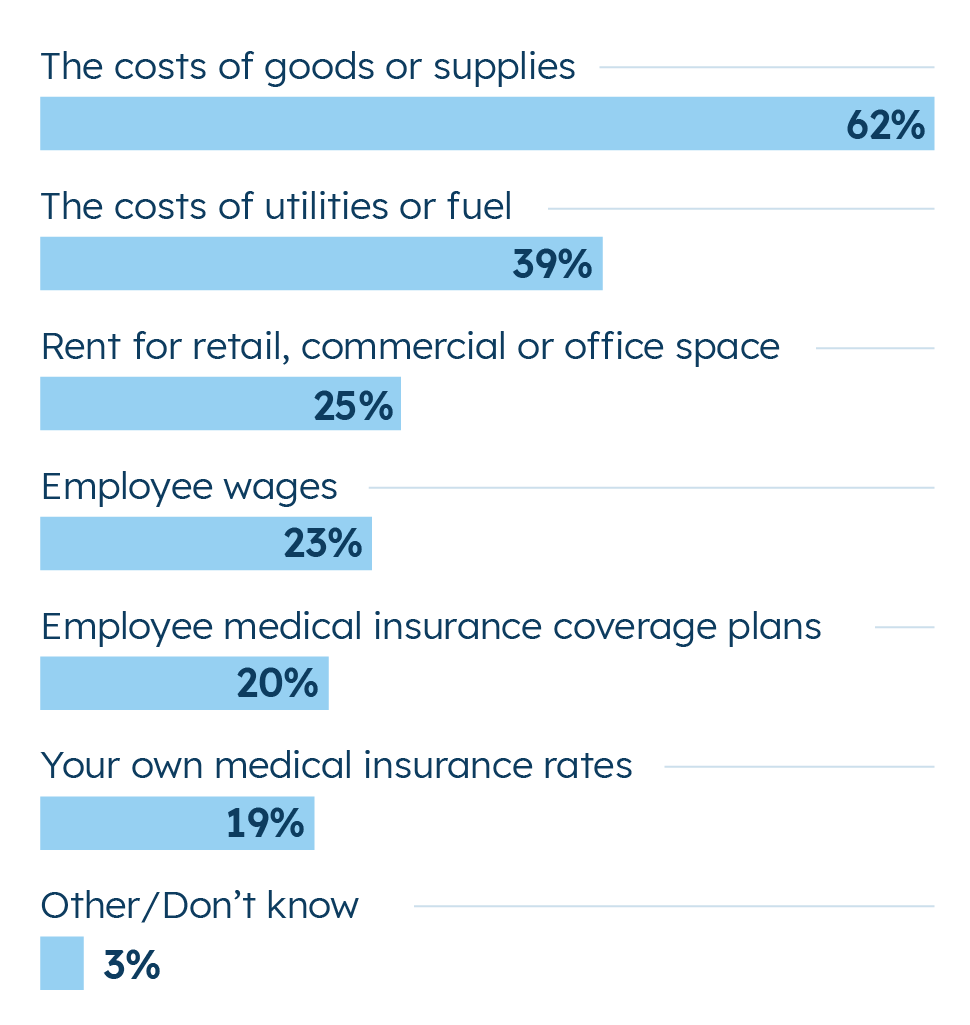

Sixty-three percent of small businesses say they have increased the prices of their own products and services in the past year. However, they also use other methods to manage inflation. Over two in five small businesses also say they have taken out a loan in the past year (45%) or have decreased staff (41%) as a way of managing higher costs due to inflation.
Generally, this pattern holds with small businesses (regardless of size or sector) being more likely to handle inflation by raising their prices, rather than taking out a loan or decreasing headcount. Small business retailers, more than anyone else, say they have taken some form of action to manage the higher costs brought on by inflation, with 70% agreeing they have increased prices, and over half reporting they have taken out a loan (58%) or let employees go (53%) in the past year.
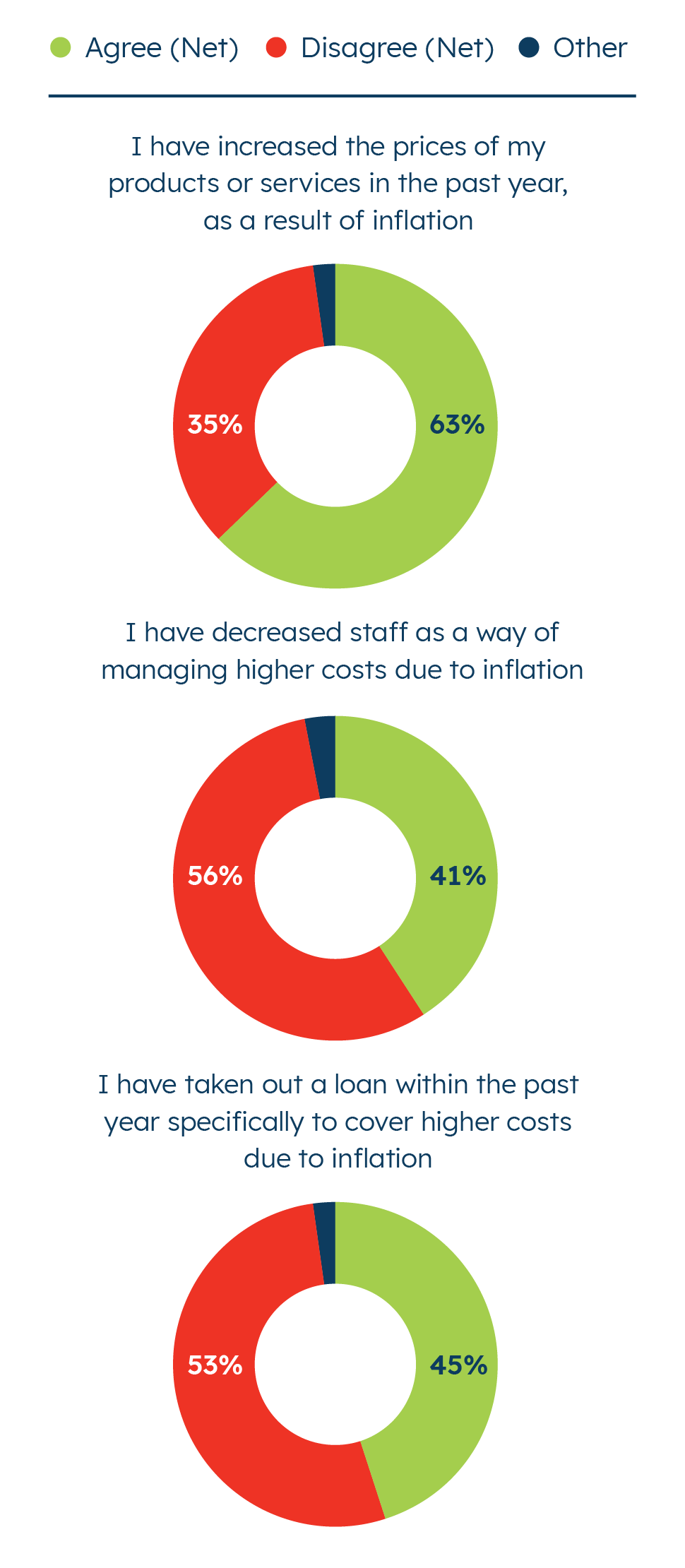

Co-CEO, Wyoming Machine
Stacy, Minnesota
Almost half of small businesses face staff shortages ahead of the holidays
Almost half of all small businesses say their business is facing a worker shortage, ahead of an important part of the business year: the holidays.
This quarter, nearly half (46%) of small business owners say they have personally experienced worker shortages at their business. However, 76% report noticing staff shortages at other small businesses in their area, and 68% say the same about other small businesses in their area that are in their same sector. Small business retailers (59%), medium-sized small businesses (58%), and larger small businesses (53%) are the most likely to report worker shortages at their business.
Unsurprisingly, most small businesses see the holidays as an important season for their bottom line. A large majority of small business owners (70%) say the holiday season is important to their overall yearly profit, with nearly four in ten (37%) saying it’s very important. This is particularly true among retailers (including restaurants and bars) and small businesses in the South.
Fewer than a third (29%) of small businesses plan to hire seasonal workers for the holiday season. Small business retailers (38%) and manufacturers (36%) are the most likely across sectors to say they intend to hire seasonal workers. About half (48%) of small business owners who say their business has experienced a labor shortage plan to hire seasonal employees, compared to 11% of small business owners who say neither their business nor other small businesses in their area have experienced worker shortages.
Small business owners also anticipate supply chain disruptions to make the upcoming holiday season difficult. Three in five (60%) small businesses say they expect supply chain disruptions to make it difficult for their business to manage the holiday season this year. Again, small business retailers (77%) are the most likely to anticipate this challenge.

Small businesses say revenue is their biggest post-pandemic challenge
However, fewer small businesses say revenue is their top concern now than did in Q3 2021 (26% in Q4 vs. 34% in Q3), and revenue is now joined in the top tier of concerns by inflation and complying with COVID-19 protocols.
When looked at collectively, it seems that small business owners’ concerns have spread out beyond revenue to a myriad of issues. For example, small business retailers say their biggest challenge is supply chain issues (27%) while those in the services sector say it’s compliance with COVID-19 safety protocols and revenue (both 33%).
From inflation to supply chain disruptions and labor shortages, small businesses are faced with several challenges at the moment. But as 2021 comes to a close, 77% of small business owners say they are optimistic about the future of their business.
